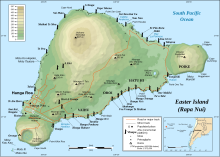geo.wikisort.org - Island
Motu Nui (large island in the Rapa Nui language) is the largest of three islets just south of Easter Island and is the most westerly place in Chile and all of South America. All three islets have seabirds, but Motu Nui was also an essential location for the Tangata manu ("Bird Man") cult which was the island religion between the moai era and the Christian era (the people of the island were converted to Roman Catholicism in the 1860s). Motu Nui is the summit of a large volcanic mountain which rises over 2,000 meters from the sea bed. It measures 3.9 hectares in land area and is the largest of the five satellite islets of Easter island. It is one of three islands that is closest to Point Nemo, the place in the ocean that is farthest from land.[1][2]


The ritual of the "Bird Man" cult was a competition to collect the first egg of the manutara. This took place starting from Motu Nui where the Hopu (representatives from each clan) waited for the sooty terns to lay their first eggs of the season. The Hopu who seized the first egg raced to swim back to Easter Island, climbed the cliffs to Orongo and presented the egg to their sponsor in front of the judges at Orongo. This gave their sponsor the title of Tangata manu and great power on the island for a year. Many Hopu were killed by sharks or by falling. The winning clan gained certain rights, including the collecting of eggs and young birds from the islets.
Motu means "island" in Rapa Nui language, and there are two smaller motus located nearby: Motu Kao Kao (a sea stack, rising around 20 meters (65 feet) above sea level) and Motu Iti (near Motu Nui).
Motu Nui was scientifically surveyed by the Routledge expedition of 1914, which reported that six other varieties of seabirds nested there in addition to the sooty tern. They explored two caves on Motu Nui, in one of which the Hopu used to stay while waiting for the first egg of the season, and the other used to contain Moai Maea "The Boundary of the Land", a small moai that had already been taken to the Pitt Rivers Museum in Oxford, England.
Although the Tangata Manu cult's rituals have long since been discontinued (the last competition known to have taken place in 1888), current visitors to Rapa Nui often enjoy the beauty of the Motus via small boat excursions from Hanga Roa, the island's only town. The diving in the sea between Motu Nui and Kau Kau is exceptional, and is a highly sought-after scuba diving location for dive enthusiasts from around the world. Once heavily populated with sharks, the coastal waters of Rapa Nui are now much safer, due in large part to overfishing.
References
- Katherine Routledge: The mystery of Easter island, Adventures Unlimited Pr 1998, ISBN 0932813488 (in Google Books and in Internet Archive ) (reprint of original book from 1919)
External links
На других языках
[de] Motu Nui
Der Motu Nui („Große Insel“ auf Rapanui) ist mit einer Fläche von 3,9 ha die größte der unbewohnten Nebeninseln der Osterinsel. Er liegt etwa 1,3 Kilometer südwestlich der Hauptinsel und ist der westlichste Punkt des Staates Chile. Motu Nui war früher mit der Hauptinsel verbunden, brach dann aber ab und versank teilweise im Meer. Dem Motu Nui sind zwei kleinere Motus vorgelagert: Der Motu Kau Kau, eine knapp 600 Meter entfernte Felsnadel, die sich etwa 20 Meter über den Meeresspiegel erhebt, und der Motu Iti, der nur durch einen wenige Meter breiten überspülten Abschnitt vom Motu Nui getrennt ist. Auch sie entstanden durch Abbrechen von der Osterinsel.[1]- [en] Motu Nui
[es] Motu Nui
Motu Nui es el mayor de los tres islotes al extremo suroeste de la Isla de Pascua, es el lugar más occidental de Chile. Los tres islotes tienen aves marinas, pero Motu Nui es un lugar esencial para el Tangata Manu ("Hombre pájaro") que era el culto de la religión de la isla entre la época de los moai y los cristianos (la isla se convirtió al catolicismo en la década de 1860). Motu Nui es la cumbre de una montaña volcánica de gran tamaño que se eleva a más de 2.000m desde el fondo del mar. La medida de áreas en hectáreas es:[fr] Motu Nui
Motu Nui, « Grand îlot » en rapanui, est un îlot de la pointe sud-ouest de l’île de Pâques, et constitue le point le plus occidental du territoire chilien, ainsi que le point méridional de l'archipel pascuan.[it] Isola di Motu Nui
L'isola di Motu Nui è la più grande delle tre isole situate poco più a sud dell'isola di Pasqua. Le altre due isole sono Motu Kao Kao e Motu Iti. Come tutte le altre isole della zona Motu Nui appartiene al Cile ed è anche la località posta più ad ovest nel territorio cileno. A Motu Nui nidificano ogni anno le sterne grigie, e proprio ad esse è legato il Culto dell'Uomo Uccello, che sostituì il culto degli antenati moai.[ru] Моту-Нуи
Моту-Нуи (исп. Motu Nui) — наибольший скалистый островок к югу от острова Пасхи. При этом он является вершиной горы, подножие которой находится более чем на 2000 м под уровнем моря.Другой контент может иметь иную лицензию. Перед использованием материалов сайта WikiSort.org внимательно изучите правила лицензирования конкретных элементов наполнения сайта.
WikiSort.org - проект по пересортировке и дополнению контента Википедии